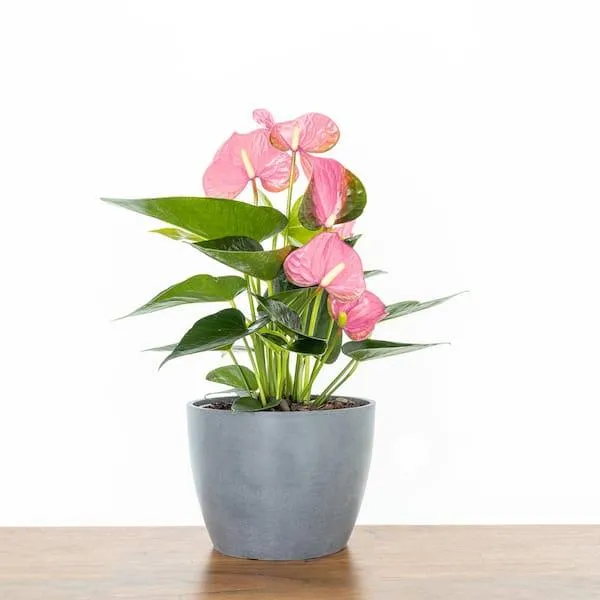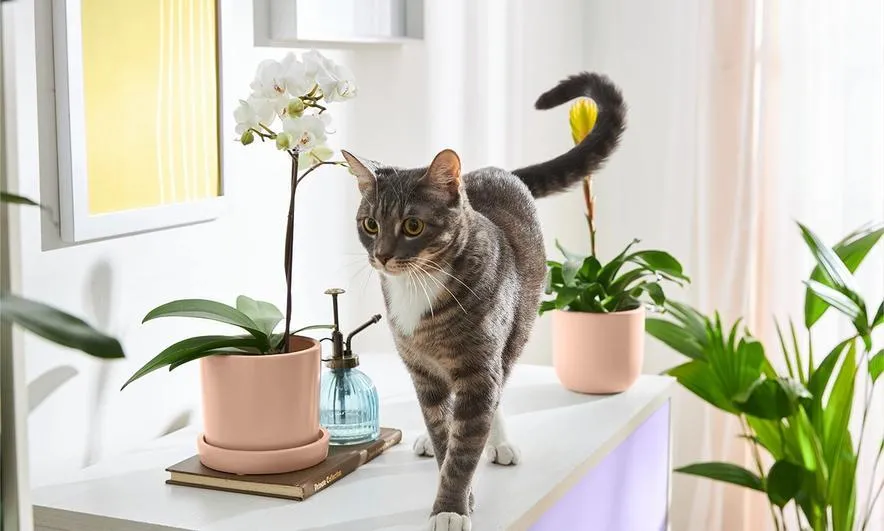Are Anthurium Plants Safe Around Pets?
If you have furry friends at home and are looking to brighten up your indoor space with some colorful flowers, you may be wondering whether Anthurium plants are a good choice. As one of the most popular houseplants, Anthuriums are known for their heart-shaped leaves and colorful waxy flowers. But are they safe to have around cats and dogs? In this article, I will address all the potential intentions of a user searching for information on “anthurium pet friendly” and provide a detailed answer based on research and personal experiences.
Toxicity Level
The good news is that most parts of the Anthurium plant – including the leaves, flowers, and stems – are not considered toxic to pets. According to the ASPCA Animal Poison Control Center, Anthuriums have a low toxicity rating and may cause only minor issues like mild upset stomach if ingested in small amounts. However, chewing or eating large quantities could potentially lead to vomiting or diarrhea in some pets.
From my experience owning pets for many years, it’s quite rare for cats or dogs to actually consume large portions of houseplants. An occasional nibble or bite is more common. So as long as the Anthurium is kept out of reach of chewing or eating, the low toxicity means it should not pose a significant health risk on its own.
Pet Safety Precautions
Nevertheless, it’s always a good idea to take some basic precautions when keeping any type of houseplant around pets:
- Keep the Anthurium and all other plants up high, such as on a bookshelf or hanging planter that pets can’t access.
- Monitor pets closely if they show interest in sniffing or touching the plant. Gently redirect their attention.
- Inspect the plant regularly for signs of chewing or damage from curious pets.
- Consider potting Anthuriums in heavy, stable pots that can’t be easily tipped over.
- Use non-toxic, pet-safe potting soil and fertilizers.
By taking these simple precautions, you can greatly reduce any potential risks to pets while still enjoying Anthurium’s beauty indoors. The key is making the plant inaccessible to pets rather than totally “pet proof.”
Cat vs. Dog Safety
In terms of which pet may be safer to have around Anthurium – cats or dogs – there’s no major difference. Both have the potential to nibble or taste test plants out of natural curiosity. However, from my experience:
Cats tend to be more curious explorers of their environment and more inclined to knock over or play with potted plants. So Anthuriums placed at floor level or within reach on low shelves pose more of a temptation. However, cats rarely eat large amounts of plants.

Dogs, meanwhile, are generally less interested in houseplants but may investigate by sniffing if the plant is accessible. Puppies going through the chewing stage are more likely to sample plants. The risk is lower if using elevated or hanging planters.
Overall though, as long as basic precautions are taken, both cats and dogs can live harmoniously with Anthuriums. It just takes being mindful of each pet’s natural behaviors and tendencies.
Additional Factors to Consider
Aside from toxicity, there are a couple other factors worth keeping in mind when deciding if Anthurium is suitable for your pet-friendly home:
Allergies
Like many flowering houseplants, Anthurium pollen could potentially trigger allergies or irritated skin/nose in sensitive pets. If your cat or dog already has plant-related allergies, it may be better to choose a low-allergen option.
Mess Factor
Anthuriums are prone to dropping leaves, deadheading blooms, and accumulating potting soil debris over time. For pets that groom themselves by licking paws and fur, any mess could potentially be ingested. It’s best to sweep up dropped leaves and debris as needed.
Dogs and Chewing
While Anthurium itself poses little chewing risk to adult dogs, the plant pot or stakes could still be targets for playful pups or those going through the destructive teething phase. Choose sturdy, chew-proof containers if a dog is in the home.
Real-Life Example
I have personal experience keeping various houseplants, including some Anthurium varieties, in a home shared with both cats and a puppy. Here’s what happened:

One of my cats is quite curious and had a habit of jumping onto plant shelves as a kitten. We added straps to secure hanging pots after she knocked over a pothos. Otherwise, she lost interest quickly upon realizing plants aren’t toys. The other cat ignores them.
Our puppy Hobbes still likes to nibble on things while teething. We had to position Anthurium and other soft-leaved plants out of reach until he was past that phase. Now at 1 year old, he doesn’t touch them and the cats leave the plants alone too with no issues.
Basically, with a little thought given to pet-proofing depending on each pet’s habits, Anthuriums have coexisted happily in our home alongside our furry companions for over 2 years now!
Final Thoughts
In summary, while Anthurium plants are not 100% pet-proof due to the potential for ingestion if chewed or eaten, they present a low toxicity risk to cats and dogs when some basic common-sense precautions are followed.
By adjusting placement heights, using pet-friendly soil/fertilizer, monitoring pets initially, and making Anthurium inaccessible through chewing or toppling, it is quite possible to safely keep these beautiful flowers indoors. Both cats and dogs can live in pet-approved harmony with Anthurium.
Of course, if you have a pet with a history of severe plant chewing, allergies, or other sensitivities, it’s always best to choose organic, non-toxic greenery more tailored to a pet-friendly home environment. Other houseplants may pose less risk. But for pet owners seeking a splash of colorful blooms, Anthuriums can certainly fit the bill.
Anthurium as Pet-Friendly Houseplants
| Plant | Light Requirement | Watering Needs | Temperature Range | Toxicity |
|---|---|---|---|---|
| Anthurium andraeanum | Bright indirect light | Keep soil moist, do not overwater | 60-80°F | Non-toxic |
| Anthurium crystallinum | Bright indirect light | Allow soil to dry out between waterings | 65-75°F | Non-toxic |
| Anthurium clarinervium | Bright indirect light | Water when top 1 inch of soil is dry | 55-75°F | Non-toxic |
| Anthurium radicans | Bright indirect light | Water when top 1 inch of soil is dry | 60-80°F | Non-toxic |
| Anthurium scherzerianum | Bright indirect light | Water when top 1 inch of soil is dry | 65-80°F | Non-toxic |
FAQ
-
Is an anthurium plant pet friendly?
Generally, an anthurium is non-toxic to pets. However, cats may be tempted to chew on the waxy leaves or flowers. So it’s best to keep an anthurium high up or secured away from where pets can reach.

-
Can dogs or cats eat an anthurium?
While an anthurium is not considered poisonous, the sap can cause some pets slight irritation if they chew or lick it. So it’s advisable to not allow pets to eat parts of the plant. At the same time, small amounts of contact are unlikely to harm animals.
-
Is an anthurium poisonous to dogs or cats?
Scientific studies show an anthurium is not highly toxic to pets. It is put in the category of “non-toxic” or “slightly toxic” plants. Nevertheless, dogs or cats should not eat large parts of the plant since it may cause some tummy upset. Keeping it high or out of reach plays it safe.
-
Can my rabbit chew on an anthurium plant?
While some sources report an anthurium is safe for rabbits, other experts advise against letting rabbits chew or nibble parts of the plant. Rabbits have a tendency to nibble, and too much an anthurium sap could potentially irritate their digestive system. So for peace of mind, it’s best to plant an anthurium out of a rabbit’s reach.
-
Is it okay if my bird plays with an anthurium?
Most evidence shows an anthurium poses low risk to birds. Birds are very least likely to eat parts of this plant. However, if your bird occasionally touches the anthurium or uses the leaves for shredding toys, it’s probably alright. Just watch that your bird does not consume large pieces. Keeping the plant high allows birds to interact without concerns.
-
Can pets be around an anthurium indoors?
For the most part, an anthurium is fine to have in a home with pets. The plant is labeled non-poisonous. Unless a pet chews off large pieces, brief contact is unlikely to do harm. Simply place the plant up high or secure it out of reach if worried. Most pets will ignore an anthurium, so it can basically co-exist with household animals indoors.
-
What precautions should I take with pets?
While an anthurium is categorized as low risk for pets, some small precautions are recommended. Keep the plant and soil up high, secured, or in a hanging basket. Monitor pets near it. Avoid leaving clippings or fallen leaves where animals can ingest lots. Watch for any chewing or licking and rinse mouths if contact occurs. On the other hand, casual proximity to the plant presents little threat.
-
Should I get rid of my anthurium if I have pets?
Not necessarily. An anthurium adds nice tropical color indoors and is fairly non-toxic. As long as basic precautions are taken – like placement out of reach – the plant can coexist with household animals. However, if worried or with highly curious pets, it may make sense to pick another type of safer plant. An anthurium only demands removal if a pet shows signs of consuming pieces. Does that help answer your question?

